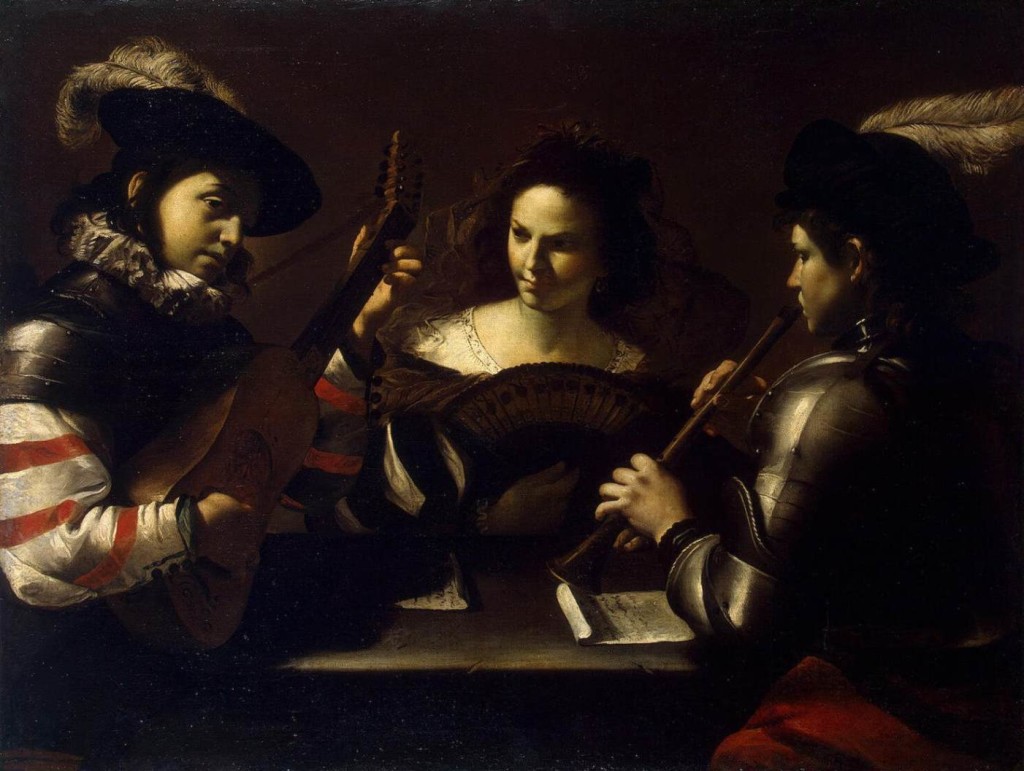12.5: Suite
- Page ID
- 72432

Introduction
A characteristic baroque form was the dance suite. Suites are ordered sets of instrumental or orchestral pieces usually performed in a concert setting. (Some dance suites by Bach are called partitas, although this term is also used for other collections of musical pieces). The dance suite typically consists of four movements (described below), plus an overture at the beginning.
Movements of the Baroque Suite
Overture
The baroque suite often began with a French overture (“Ouverture” in French), which was followed by a succession of dances, principally the following four:
Allemande
Often the first dance of an instrumental suite, the allemande was a very popular dance that had its origins in the German Renaissance era. The allemande was played at a moderate tempo and could start on any beat of the bar.
Listen: Allemande
You can listen to an example of the allemande from Bach’s Cello Suite No. 1 below:
Courante
The second dance is the courante, a lively, French dance in triple meter. The Italian version is called the corrente.
Sarabande
The sarabande, a Spanish dance, is the third of the four basic dances, and is one of the slowest of the baroque dances. It is also in triple meter and can start on any beat of the bar, although there is an emphasis on the second beat, which creates the characteristic “halting” or iambic rhythm of the sarabande.
Listen: Sarabande
Below is the sarabande from Bach’s Cello Suite No. 1:
Gigue
The gigue is an upbeat and lively baroque dance in compound meter, typically the concluding movement of an instrumental suite, and the fourth of its basic dance types. The gigue can start on any beat of the bar and is easily recognized by its rhythmic feel. The gigue originated in the British Isles. Its counterpart in folk music is the jig.
Listen: Gigue
Below is the gigue from Bach’s Cello Suite No. 1:
Optional Movements
These four dance types (allemande, courante, sarabande, and gigue) make up the majority of seventeenth-century suites; later suites interpolate one or more additional dances between the sarabande and gigue:
- Gavotte – The gavotte can be identified by a variety of features; it is in 4/4 time and always starts on the third beat of the bar, although this may sound like the first beat in some cases, as the first and third beats are the strong beats in quadruple time. The gavotte is played at a moderate tempo, although in some cases it may be played faster.
- Bourrée – The bourrée is similar to the gavotte as it is in 2/2 time although it starts on the second half of the last beat of the bar, creating a different feel to the dance. The bourrée is commonly played at a moderate tempo, although for some composers, such as Handel, it can be taken at a much faster tempo.
- Minuet – The minuet is perhaps the best-known of the baroque dances in triple meter. It can start on any beat of the bar. In some suites there may be a Minuet I and II, played in succession, with the Minuet I repeated.
- Passepied – The passepied is a fast dance in binary form and triple meter that originated as a court dance in Brittany.Examples can be found in later suites such as those of Bach and Handel.
- Rigaudon – The rigaudon is a lively French dance in duple meter, similar to the bourrée, but rhythmically simpler. It originated as a family of closely related southern-French folk dances, traditionally associated with the provinces of Vavarais, Languedoc, Dauphiné, and Provence.
Other Features
- Entrée (ballet) – Sometimes an entrée is composed as part of a suite; but there it is purely instrumental music and no dance is performed. It is an introduction, a march-like piece played during the entrance of a dancing group, or played before a ballet. Usually in 4/4 time. It is related to the Italian “intrada.”
- Basso continuo – a kind of continuous accompaniment notated with a new music notation system, figured bass, usually for a sustaining bass instrument and a keyboard instrument.
- The concerto and concerto grosso
- Monody – an outgrowth of song
- Homophony – music with one melodic voice and rhythmically similar accompaniment (this and monody are contrasted with the typical Renaissance texture, polyphony)
- Dramatic musical forms like opera, dramma per musica
- Combined instrumental-vocal forms, such as the oratorio and cantata
- New instrumental techniques, like tremolo and pizzicato
- The da capo aria “enjoyed sureness”
- The ritornello aria – repeated short instrumental interruptions of vocal passages
- The concertato style – contrast in sound between groups of instruments
- Extensive ornamentation
Listen: Orchestral and Instrumental Suites
Learn about and listen to orchestral suites at the sites below:
J. S. Bach, Orchestral Suite No. 2 in B Minor BWV 1067
G. F. Handel, Music for the Royal Fireworks
Listen to examples of instrumental suites at the following sites:
J. S. Bach, Sonatas and Partitas for Violin Solo
J. S. Bach, Cello Suites
Contributors and Attributions
- Revision and adaptation. Provided by: Lumen Learning and Natalia Kuznetsova . License: CC BY-SA: Attribution-ShareAlike
- Baroque Music. Provided by: Wikipedia. Located at: https://en.Wikipedia.org/wiki/Baroque_music#Dance_suite. License: CC BY-SA: Attribution-ShareAlike
- Rostropovich - Bach Cello Suite No.1 - Allemande. Authored by: Umut Sau011fesen. Located at: https://youtu.be/S9ZVuV8Py24. License: All Rights Reserved. License Terms: Standard YouTube license
- Mstislav Rostropovich - Bach suite 1 III. Courante. Authored by: Cayo255. Located at: https://youtu.be/fXtpN4oXr5Y. License: All Rights Reserved. License Terms: Standard YouTube license
- Rostropovich plays the Sarabande from Bach's Cello Suite no. 1. Authored by: inwit. Located at: https://youtu.be/ZXnujMPt30Q. License: All Rights Reserved. License Terms: Standard YouTube license
- Mstislav Rostropovich - Bach Cello Suite 1 VI. Gigue. Authored by: Cayo255. Located at: https://youtu.be/J7OBpnPkYw4. License: All Rights Reserved. License Terms: Standard YouTube license
- Concert. Authored by: Mattia Preti. Located at: https://commons.wikimedia.org/wiki/File:Mattia_Preti_-_Concert_-_WGA18386.jpg. License: Public Domain: No Known Copyright

